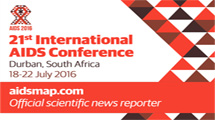By Yogan Pillay
At the XIII International Aids Conference, July 2000, held in Durban, South Africa, Nelson Mandela commented on the devastating impact HIV/AIDS was having on families, communities, societies and economies around the world. He told the conference that “decades have been chopped from life expectancies. AIDS is clearly a disaster. The most frightening thing is that all of these new infections and the human suffering could have been and many more still can be prevented. Something drastic needs to be done”.
We also need to remember what Madiba said at the closing of that Conference in 2000: “With nearly two decades of dealing with the epidemic, we should have some experience of what works. The challenge now is to move from rhetoric to action; action at an unprecedented intensity and scale. There is a need for us to focus on what we know works”.
Sixteen years later, the 21 International AIDS conference will open on 18 July 2016, in Durban, South Africa. It is also the day that the UN has declared as International Nelson Mandela Day. His messages were relevant in 2000 and remain relevant today.
The story of AIDS all began as a medical mystery. As time went on, however, we gradually began to see that what we were experiencing was much bigger than we had first imagined. Once it was clear from the scientific literature that the disease was sexually transmitted, it also became clear that the disease would not be limited to (men who have sex with men). And once we knew that the agent was a virus we knew many more people were at risk.
The medical mystery would soon become the global pandemic. Over 50 million people have died of AIDS since the start of the epidemic. With the possible exception of the Spanish influenza pandemic, this is the shortest period of time in which so many people have died of a single infectious agent in human history.
The cause of Aids has been discovered, been named, become a deadly global epidemic and become treatable, all in less than three decades. In a generation it has evolved into a dreaded scourge and then into a chronic manageable disease.
Its spread and growth were made possible by an increasingly globalised world, in which communication, travel and migration have woven the world’s people together. Yet, in contrast to the many plagues of human history, the same factors responsible for its spread have helped raise the billions of dollars that have made HIV infection treatable.
It is estimated that between 60 and 65 million people are living with HIV globally, ten million of whom are children – mainly in the developing world. Of these 6,8 million people living with HIV are in South Africa, according to UNAIDS estimates. According to the UN, in the period 2004-2009, there were about 900 deaths a day.
However, much progress has been made globally and in South Africa. South Africa for example has seen a significant increase in life expectancy since antiretroviral therapy has become available in the public health sector, especially since the scale up of the treatment programme in 2009.
The South Africa Medical Research Council’s rapid mortality survey report estimated that life expectancy has increased from 57 years in 2009 to 63 years in 2014 – which is largely ascribed to having large number of people on treatment, more than 3 million by 2016! Similarly, the MRC also reported that maternal mortality has declined by about half from 302/100 000 live births in 2009 to 155/100 000 live births in 2013 – again largely ascribed to HIV treatment. Also, the country should be proud of the significant reduction in mother to child transmission from around 30% in 2003 (before the introduction of the prevention of mother-to-child transmission programme) to less than 1.5% at 6 weeks postnatally in 2015.
As the International AIDS Conference returns to Durban this year, the fight against the epidemic must be intensified.
Let us return to Durban in order to reflect on our journey from hopelessness to a country with the largest HIV and AIDS treatment in the world and a significantly lower mother to child transmission of HIV rate.
Let us also return to Durban , to reflect on what South Africa has done to heed the call of the founding father of our democracy who said: “We need bold initiatives to prevent new infections among young people, and large-scale actions to prevent mother-to-child transmission, and at the same time we need to continue the international effort of searching for appropriate vaccines; we need to aggressively treat opportunistic infections; and we need to work with families and communities to care for children and young people to protect them from violence and abuse, and to ensure that they grow up in a safe and supportive environment”.





